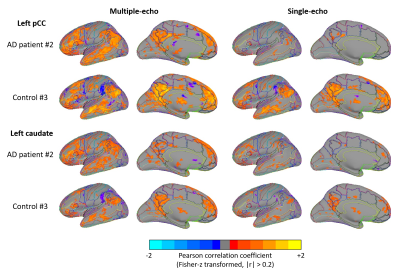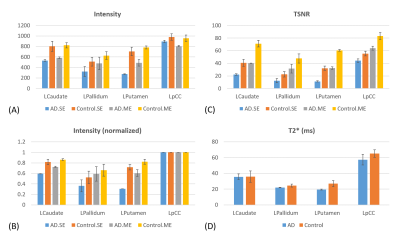Daehun Kang1, Myung-Ho In1, Erin Gray1, Thomas K Foo2, Radhika Madhavan2, Nolan K Meyer1, Lydia J Bardwell Speltz1, Zaki Ahmed1, Jeffrey Gunter1, Brice Fernandez3, Joshua D Trzasko1, John Huston1, Matt A Bernstein1, and Yunhong Shu1
1Radiology, Mayo Clinic, Rochester, MN, United States, 2GE Global Research, Niskayuna, NY, United States, 3GE Healthcare, Buc, France
1Radiology, Mayo Clinic, Rochester, MN, United States, 2GE Global Research, Niskayuna, NY, United States, 3GE Healthcare, Buc, France
T2*-weighted-combined
multi-echo EPI is well-suited for fMRI of subjects with dementing illnesses
such Alzheimer's disease due to improvements in TSNR and BOLD contrast
sensitivity especially regions with high iron-deposits or substantial brain
atrophy.

Fig. 5. Individual
examples from a AD subject and a healthy subject: functional connectivity derived
from left posterior cingulate cortex (pCC) and left caudate as seeded region
respectively.

Fig. 4. Four ROIs defined on a brain template are selected
as study regions on both the SE and ME images obtained from AD patients and
healthy control subjects. (A,B) averages of images intensity and the
intensities normalized to those in pCC are evaluated in the ROIs. (C) temporal
SNR and (D) the measured regional T2* are plotted. Signal dropout and TSNR were
improved by using the ME combined images compared to the SE images only images.